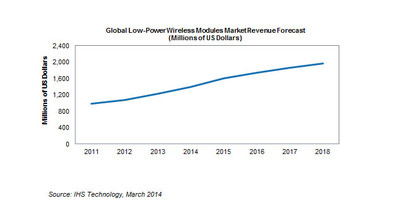Double-digit growth forecast for low-power wireless modules
IHS Technology has released the ‘Low Power Wireless Modules Report - 2013’, which presents market estimates (2011 and 2012) and annual forecasts (2013 to 2018) for the shipments, revenues and average selling prices of 15 low-power wireless technologies. The report finds that the global market for low-power wireless modules will enjoy strong double-digit growth this year.
Revenue worldwide for the low-power wireless modules market will reach $1.40 billion this year, up 14% from $1.23 billion in 2013. This will be the third consecutive year of expansion for the market in the double digits, to be repeated for a fourth and final time next year, according to IHS, after which growth moderates slightly to the mid and high single digits.

“Low-power wireless modules play an important role in the wireless ecosystem, providing a turnkey solution that includes a radio, microcontroller, non-volatile memory and antenna - all in a small, affordable package,” said Lee Ratliff, principal analyst for connectivity at IHS and author of the report.
He added, “Low-power wireless modules are increasingly being incorporated within industrial, commercial and consumer applications.” They are especially popular in low-volume applications, he said, because they eliminate the high non-recurring development expenses associated with radiofrequency (RF) design, verification and certification.
Ratliff said modules also find favour in devices that ship in millions of units because they simplify manufacturing and increase flexibility. A single module design can be re-used across multiple product SKUs. Modules can also give life to an old product by upgrading the wireless performance without changing the overall hardware design of the product.
The fastest-growing markets forecast for the modules will be in sports and fitness monitoring, with a compound annual growth rate (CAGR) of 49%. Other markets include consumer electronics with a CAGR of 36%, automotive with 32% and residential automation with 30%. There will also be a high rate of module use in rapidly growing technologies like Bluetooth Smart, EnOcean, ZigBee RF4CE and Z-Wave.
An important trend in the adoption of low-power wireless technology is the move away from proprietary protocols, Ratliff observed, which made up 88% of module shipments in 2011 but will only account for about 50% by 2018. The falloff is driven by a growing trend among commercial buyers wishing to avoid being locked into a single vendor and to achieve interoperable communications across diverse systems, and by consumers wanting devices to communicate with mobile platforms.
The market for low-power wireless modules will be robust from 2011 to 2018 and beyond, IHS forecasts, because the factors that lead to manufacturers choosing modules are unlikely to change considerably. While each application has a volume break where modules start to lose their appeal, the break point may be lowered in the future by evolving product development trends. Furthermore, some high-volume, price-sensitive applications will continue to choose modules to allow manufacturing flexibility and design re-use among multiple SKUs.
The report can be found here.
Chicago gets USA's largest subway 4G system
By the end of 2015, Chicago will have the largest public transit system in the US with 4G...
Motorola rumoured to soon be up for sale
Industry observers expect Motorola Solutions to soon be up for sale, following stagnant market...
Motorola wins Canadian emergency comms contract
Emergency services in Vancouver have selected Motorola's ASTRO P25 to replace the current...





